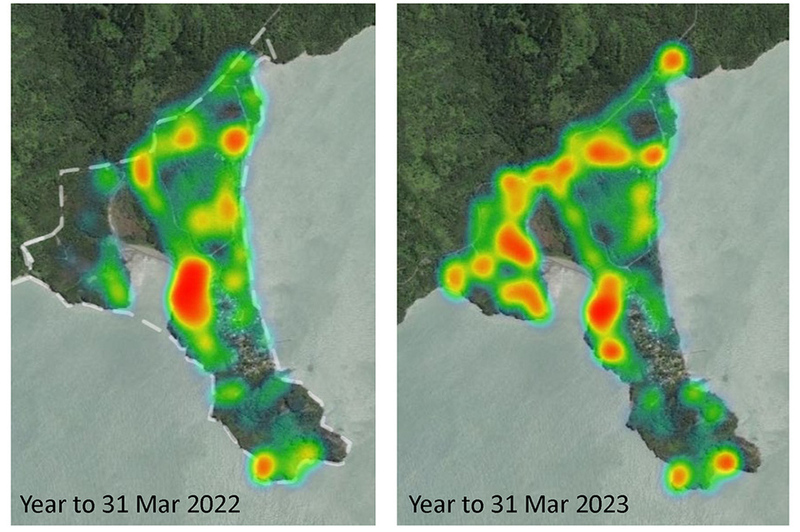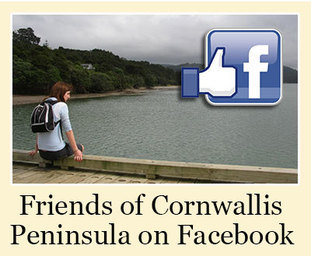News round-up from Cornwallis
Sustainable Coastlines beach clean-up
The Sustainable Coastlines public clean-up event for Cornwallis Beach attracted a large crowd of volunteers, eager to remove any trash and pieces of plastic they could find.
The event was held in warm, sunny weather on Saturday 9 November, with volunteers spreading further afield than just Cornwallis. The clean-up area covered from Mill Bay to Little Huia.
 Sustainable Coastlines is a NZ charity that started in 2009 and exists to protect our seas and coasts by bringing people together to reduce plastic pollution and other litter. Its goal is to see 60% less litter on the coastlines by 2030.
Sustainable Coastlines is a NZ charity that started in 2009 and exists to protect our seas and coasts by bringing people together to reduce plastic pollution and other litter. Its goal is to see 60% less litter on the coastlines by 2030.
Following volunteer registration, the event began at 9.30am with a health and safety briefing from Engagement Manager Dan Downing (pictured above). Then the volunteers were divided into different groups and the clean-up began.

 Included amongst the groups was a team selected to contact a trash audit of Kakamatua Inlet – a popular reserve for dog walkers.
Included amongst the groups was a team selected to contact a trash audit of Kakamatua Inlet – a popular reserve for dog walkers.
The audit involved selecting a 1000sq/m beach area and collecting and counting every piece of trash found.
The results go towards Sustainable Coastlines’ Litter Intelligence programme.
 At the same time as the beach clean-up, local community group SCOW (Save Cornwallis Old Wharf) organised a roadside clean-up. SCOW team members walked sections of Cornwallis Road pulling trash and old tyres out of the bush and leaving it for the Sustainable Coastlines team to collect.
At the same time as the beach clean-up, local community group SCOW (Save Cornwallis Old Wharf) organised a roadside clean-up. SCOW team members walked sections of Cornwallis Road pulling trash and old tyres out of the bush and leaving it for the Sustainable Coastlines team to collect.
A total of 5420 litres or 510kg of litter was collected across 7.5km of coastline.
 At the conclusion of the public clean-up, event sponsors Tip-Top Trumpet and Phoenix Organics drinks provided free ice creams and refreshments for the volunteers – which included a large number of families.
At the conclusion of the public clean-up, event sponsors Tip-Top Trumpet and Phoenix Organics drinks provided free ice creams and refreshments for the volunteers – which included a large number of families.
Games were also available for people to play and relax on Cornwallis Beach on a very sunny Saturday afternoon. The event was also supported by Auckland Council.
Heat map shows predator hot spots

A new “heat map” has been produced to show the hot spots in the ongoing war against predator mammals at Cornwallis (Karanga ā Hape).
A control programme targeting rats, mice, stoats and possums has been running on the peninsula for over eight years now and was recently extended to include the land west of the Kakamatua Inlet.
The total area under control is 310 hectares, of which privately owned land and dwellings makes up just 10%.
In the last 12 months to 31 March 2023, they were1804 trap “hits”, of which it is estimated that:
- 1671 were rats
- 27 were stoats (including 4 weasels)
- 79 were mice
- 21 hedgehogs.
This compares with 1318 hits for the 12 months to 30 Sept 2022. The large increase can be credited to the increased number of traps now activated in the land west of the Kakamatua Inlet.
The heat map shows the key battleground areas, where trap activity is at its highest. Some activity is still being recorded at the southern tip of the peninsula on Puponga Point, the location of the grey-faced petrel colony, however control programme organisers believe the predator threat is under control there and petrel colony is now slowly growing.
With fewer rats, stoats and mice on the peninsula, invertebrates such as weta and the numerous bird species (including penguins and grey-faced petrels) that were once prolific in the area, are beginning a slow recovery. At least a third of local fledgling petrel chicks are estimated to make it through to adulthood, which is considered good for a land-based colony.
The control work is being carried out by local community group SCOW, which originally formed to “Save Cornwallis’ Old Wharf”, but now works to help maintain and upgrade assets throughout the peninsula. This includes helping with such issues as removing graffiti from the wharf, communicating with Auckland Council on stormwater drain clearance and lobbying for better footpaths along Cornwallis Road.
A sub-group of SCOW, known as the Petrelheads – due to its work in protecting the grey-faced petrel colony on the southern tip of the peninsula – currently organises the control work, with generous financial support from The Trusts, the Waitākere Ranges Local Board and Auckland Council.
Alex Duncan of the Petrelheads says they are indebted to those people who regularly check trap lines each month or so, but they are also looking for more volunteers to help with this work. If you are interested, you can email pestfreecornwallis@gmail.com for more information.
The Petrelheads work alongside a similar team in nearby Huia that is also doing predator control work.
Cornwallis Beach Tweets
Efforts to protect grey-faced petrel at Cornwallis Peninsula have got a boost - thanks to a new wildlife camera. Funding came from the EcoMatters Trust and Waitakere Ranges Local Board. The camera monitors the activity and health of the colony - plus records predator incursions. pic.twitter.com/4nMO04dzJG
— Cornwallis Beach (@Cornwallis_NZ) March 13, 2025
Photographed by Donald Jenkins 100 years ago in 1924, this image of #CornwallisBeach is part of the Auckland Libraries Heritage Collection. pic.twitter.com/KPuXumC3AT
— Cornwallis Beach (@Cornwallis_NZ) August 11, 2024
A spectacular view of the #sunrise over the pier at Cornwallis Beach #NewZealand.#landscapephotography #seascape #photography pic.twitter.com/N4ACWEHxER
— Jacques Olivier (@WanderingPlank) May 24, 2023
Looking south from the northern end of #CornwallisBeach - Photo taken February 1969 by John Thomas Diamond, part of the Auckland Libraries Heritage Collection. pic.twitter.com/85JebdPHnH
— Cornwallis Beach (@Cornwallis_NZ) May 16, 2023
Quick photos from Whatipu in #Auckland #NZ from the current geomagnetic storm #AuroraAustralia #Aurora pic.twitter.com/5Vo8u6lrIp
— Henderson Photographic Society (@HendersonPSoc) May 11, 2024
— Cornwallis Beach (@Cornwallis_NZ) August 9, 2022
- Buy a trap
- Cornwallis high and low tide chart
- Fishing tides for Manukau Harbour
- Is Cornwallis safe for swimming?
- Facilities at Cornwallis Beach
- MPI fish and shellfish regulations
- Waitākere Ranges Local Board
- Manukau Harbour Restoration Society
- Detailed swell map for region
- Huia Settlers Museum website
- Huia & Cornwallis Ratepayers Assoc.


